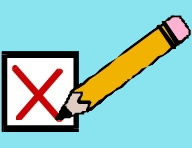
The Count
After the polls have closed you and your team will check your unused knocking-up sheets, look at the list of unfulfilled promises and probably have a pretty good idea whether you have won or not.
At this time you, if you are the candidate should probably have a shower, possible a shave (if you are male) put your best outfit on and head off to the count.
The important thing to remember is that the count is an important part of the proceedings and is not just so that the mayor or returning officer can make the result announcement and everyone can claim to have done better than expected.
There are two jobs for you and your team to do at the count. They are 'Vote Validation' and 'Ballot Counting'.
Ballot Counting
The returning officer's staff first count the number of ballot papers in each ballot box to make sure that the number of ballots they gave out in the polling station equates to the number of votes cast. They normally do this with the ballot papers face down, although I have seen it done face up. You can usually see the impression of the 'X' through the paper.
It is at this point that you conduct your 'Ballot Counting'.
Ballot Counting in its simplest form involves having a pencil and a piece of paper and ticking the paper in 5 bar gates each time you see a vote for your candidate counted. You can also use columns for each candidate or party and try to do this or all parties to see who did well or badly in any particular polling district.
This is the only chance you have to break your vote down to the level of each polling district and it is only intended to be indicative. You cannot validate any of the figures you collect this way so use them as a rough guide only. Where it is useful is in estimating support in polling districts which you may not have canvassed, or not canvassed completely. Assuming you will stand again if unsuccessful the first time the Ballot Counting figures may suggest a more favourable ward to stand in at a Council Election.
Vote Validation is carried out by the returning officer together with the Agents for all the candidates, so if you have an Agent this is their job alone.
To explain Vote Validation I have to explain that the process of voting involves putting a 'X' in a box next to the name of your preferred candidate. It sounds simple enough and most people manage to do itbut there are always a small number of ballots where for a host of reasons it is not absolutely certain how the voter intended to vote. These can be due to putting something other than an 'X' on the paper, putting the 'X' on the line between boxes, or too close to the line for certainty, or frquently voting more often than they are supposed to. In multi-member council election it has been known for multiple votes to be sqeezed into the box of one candidate.
These uncertain votes arre pulled out by the Returning Officers staff and considered by the Returning Officer and the Agents who can decide that a vote is a spoiled ballot or return it to the count as a vote for a particular candidate if that is their decision. In close elections this can decide who wins so ensure your Agent is prepared to fight your corner.
Continue to Post Election Party....